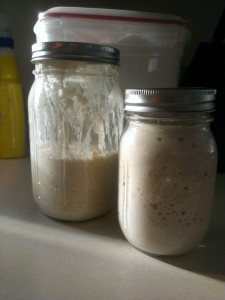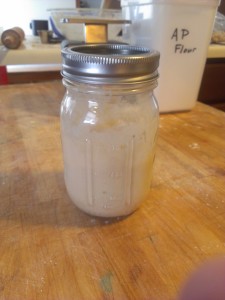first, a brief history: i started baking bread using this no-knead recipe that my brother made one year for a holiday, it was easy and tasty. then i moved on to other yeast bread recipes, mostly from the back of red star yeast packages. it amazed me how easy it is to make something so delicious with a little work and i’ve tried a few varieties of white bread, wheat bread, dinner rolls, buttermilk biscuits, cinnamon rolls, and pizza dough. i’ll document and post those in the future.
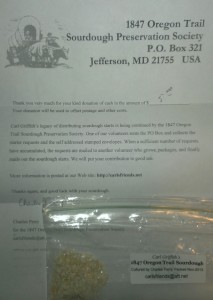
my latest experiments are with sourdough. pretty much all my knowledge has come from sourdoughhome.com, and i follow his advice on maintaining starter and converting yeast recipes to sourdough. you can find all that info on his site, so i won’t duplicate it all here. basically sourdough starter is a yeast culture that you keep alive and use in place of dried baker’s yeast like red star that you buy in the store.
i got my starter mailed to me for the cost of a S.A.S.E by going to carlsfriends.net, writing them, and a few weeks later receiving some dried Carl Griffith’s 1847 Oregon Trail Sourdough Starter. i followed their instructions and pretty soon had some live, bubbly starter.
today, i used some of that starter to make the bread at the top of the post, however i forgot to start documenting with photos, so the actual bread recipe will come in a later post – here i will just be showing how i use and maintain the starter.
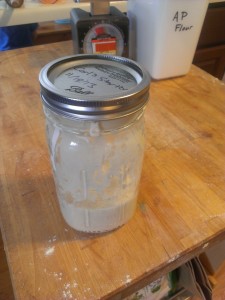
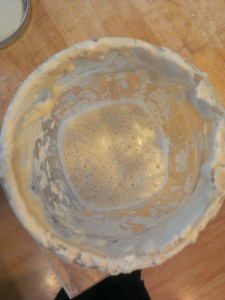
first, you need something to keep your starter in. i use a wide mouth quart canning jar with a lid that i screw on loosely, so it has a lot of room to expand and is easy to get a spoon in there to stir.
this starter was fed a long time ago, so it’s bubbly but has gone past the most active stage. i try to feed my starter every 12 hours when i don’t have it in the fridge, and i use a small postal scale to weigh the flour and water that i add.
the jar i use weighs about 16 oz (1lb), so i just consider 1 lb to be 0 since i can’t tare this scale.
now, to feed starter, add its weight in half flour + half water by weight. since you double the weight when you feed it, you would have an exponentially growing mass of yeast, (in one week, your 8oz would be over 8,000 lbs.) so you just dump out half of it before feeding each time and then replace that weight with half flour/water.
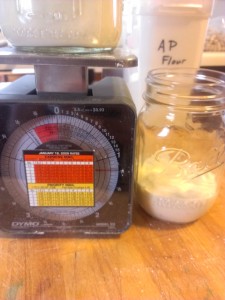
i am planning on sharing my starter, so instead of dumping it in the trash this time, i poured it into a smaller jar.
to feed each jar, which has 4 oz of starter, i added 2 oz flour and 2 oz water, by weight, then stir it up and set it on the counter. it’s also good to scrape down the sides of the jar into the starter. i use unbleached all-purpose to maintain the starter, but use bread flour when baking with it.
after a few hours, the starter will get all bubbly and increase in volume, this is when it is ‘active’ and good to use in recipes. i used 1 cup in the recipe i made today. if your recipe calls for more, you can just keep doubling it without dumping it out until you have enough.
alternately, you can refrigerate your starter shortly after feeding it if you don’t plan on using it soon, this slows down the yeast. to maintain a refrigerated starter, just remove it from the fridge about once a week, let it warm up, dump out half, feed it, then put it back. the sites i’ve read recommend going through one or two feeding cycles after removing a refrigerated starter.
your jar will probably get crusty around the lid after awhile, just pour the starter into a new one and wash the old one.
